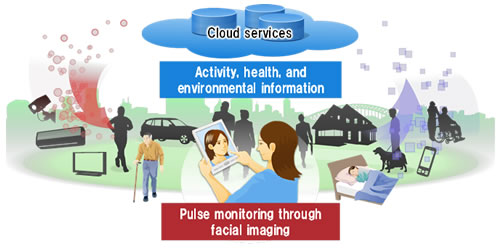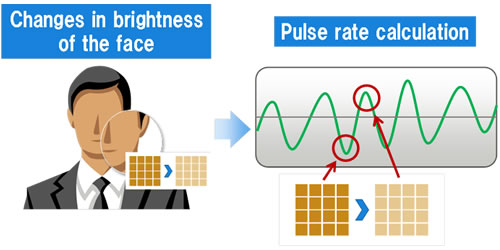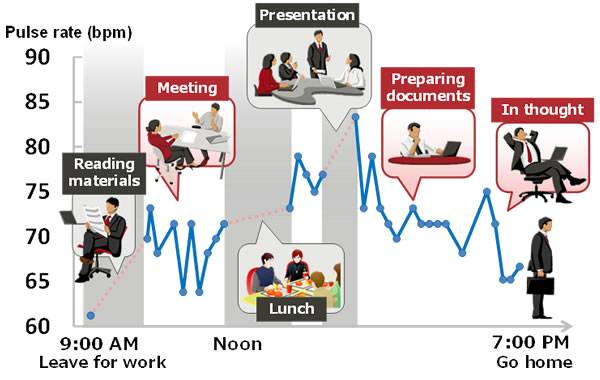Kawasaki, Japan, March 18, 2013
Fujitsu Laboratories Limited today announced that it has developed a technology to measure a person's pulse in real time using a built-in camera or webcam in a PC, smartphone or tablet.
Fujitsu Laboratories has developed a technology that detects a person's pulse by measuring variations in the brightness of the person's face thought to be caused by the flow of blood. It is based on the characteristic of hemoglobin in blood, which absorbs green light. It requires no special hardware and can measure pulse rate simply by pointing a camera at a person's face for as little as five seconds. It also automatically chooses moments when the person's body and face are relatively still to minimize the effects of irrelevant data on measurements. This technology has a wide range of potential uses, including health monitoring and maintenance as well as security applications.
Details of this technology are being presented at the 2013 General Conference of the Institute of Electronics, Information, and Communication Engineers, opening March 19 in Gifu, Japan.
Background
In recent years, there has been increasing awareness about the need to maintain the health of employees and senior citizens, raising the demand for new, more convenient ways for individuals to monitor and manage their health, anytime and anywhere.
As part of a health-support service that can be customized to each person's needs, Fujitsu Laboratories is aiming to create a way for people to track their health and store the resulting data in the cloud for analysis, helping them better understand their health and how it changes over time.
Fujitsu is committed to building the technological platforms needed to advance the Company's vision of a Human Centric Intelligent Society, making it possible for people to use smartphones or tablets, or a computer at work or at home, to track their health, collect the resulting data, upload it to the cloud, and perform real-time analyses to provide individualized services for their personal needs.
 Figure 1. Health support services based on human-centric computing
Figure 1. Health support services based on human-centric computing
Technological Issues
One fundamental indicator of human health condition is pulse. However, pulse monitoring typically requires specialized equipment that must be worn and operated with some care. These inconveniences make it more likely that users will fail or forget to have their pulse monitored. Accordingly, there has been a need for an automated way to measure pulse that minimizes the inconvenience of hooking up and operating the equipment as well as sitting still while it works.
Newly Developed Technology
Fujitsu Laboratories has developed a technology that automatically measures pulse in real time using facial images captured using the built-in camera on a smartphone, tablet, or PC. Key features of this technology are as follows.
1. Detects pulse by signal processing of extracted color components
One characteristic of hemoglobin in blood is that it absorbs green light. Based on this fact, Fujitsu Laboratories has developed a technology that detects a person's pulse by measuring changes in the brightness of the person's face as blood flows through it. The technology starts to work by shooting video of a subject and calculating average values for the color components (red/green/blue) in a certain area of the face for each frame. Next it removes irrelevant signal data that is present in all three color components and extracts the brightness waveform from the green component. The pulse rate is then computed based on the peaks in that brightness waveform (Figure 2). This technique can measure pulse in as little as five seconds.
 Figure 2. How pulse is detected
Figure 2. How pulse is detected
2. Automatically removes moving segments
The acquired pulse data that is adversely affected by movements of the face or body is automatically removed. For example, moments when a person's head turns sideways while talking on the phone or standing up from a chair are automatically detected and removed. This makes it possible to continually monitor pulse during the course of a day while minimizing the impact of irrelevant data (Figure 3).
 Figure 3. An illustration of pulse changes along with staple activities recorded over the course of one day
Figure 3. An illustration of pulse changes along with staple activities recorded over the course of one day
Results
This technology relieves people from wearing or operating any specialized equipment or sitting still for long periods in order to have their pulse measured, and makes it possible to continually monitor pulse. For example, even at a busy workplace, or any time a person is sitting in front of a PC, whether for teleconferencing or writing e-mails, their pulse can be measured during brief moments of quiet. At home, a camera built into a TV can measure the pulse of people relaxing in front of it, or a mirror, for when people are getting ready in the morning. Pulse detectors built into gates at event sites or control points at airports could be a possible security application by detecting people in ill health and people acting suspiciously.
Future Plans
Fujitsu Laboratories seeks to put this technology into practical use in fiscal 2013 for a variety of application scenarios such as a security or health monitoring and maintenance solution, building it into smartphones, tablets, and PCs.
![]() E-mail: hustle-free-press2013@ml.labs.fujitsu.com
E-mail: hustle-free-press2013@ml.labs.fujitsu.com

